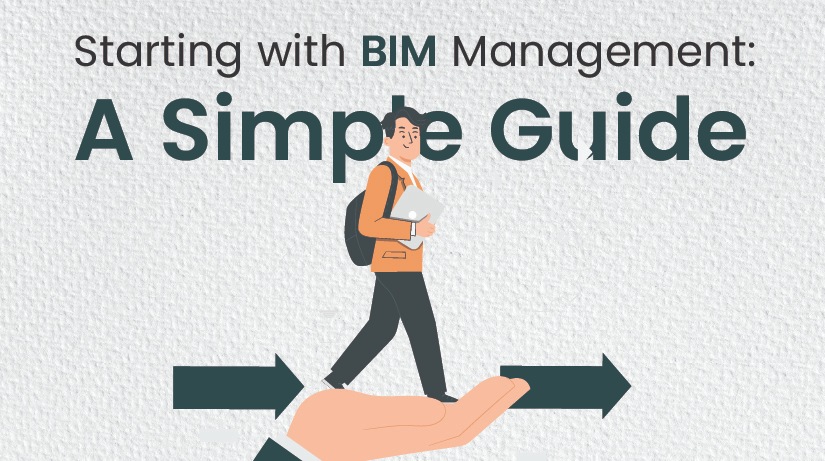Starting with BIM Management: A Simple Guide
Sep 27, 2023
Category: BIM / Digitization / Automation
SEO TSA

In the dynamic realm of Architecture, Engineering, and Construction (AEC), where innovation is the cornerstone, Building Information Modeling (BIM) emerges as a powerful catalyst. BIM management, a pivotal component, propels projects into the digital age, optimizing processes and ushering in a new era of efficiency.
This guide navigates the uncharted areas of BIM implementation, unraveling its significance and offering a roadmap for seamless integration. This will help you to start with your career and firm as well if you crack the code of getting the right projects for yourself.
BIM is the Trend of Today and Tomorrow
BIM isn’t just a trendy term; it’s a game-changing power that’s reshaping how things work in architecture, engineering, and construction (AEC). BIM brings together designs, information, and teamwork, making projects work better at every stage and creating a path for amazing efficiency and new ideas. Its influence echoes through the whole industry, changing what can be done and pushing projects into the digital era.
Imagine BIM like a master puzzle solver. It takes all the different pieces of a project – the drawings, materials, costs, and people – and fits them together perfectly. This means fewer mistakes, less wasted time, and more exciting designs. BIM doesn’t just stay in one corner of the AEC world; it’s like a ripple effect that touches everything, changing the way people plan, build, and manage projects. It’s not just a tool; it’s a whole new way of making things happen.
AEC Professionals: An Eminent Change
In the world of Architecture, Engineering, and Construction (AEC), some professionals may feel uneasy when it comes to adopting new methods. They worry about leaving behind familiar ways. However, embracing Building Information Modeling (BIM) brings opportunities for growth. This section uncovers these concerns and shows how venturing into BIM can lead to new horizons in the AEC domain, despite initial hesitations.
Implementation of BIM: Starting Fresh
Navigate BIM implementation: Select a pilot project, craft a comprehensive BIM plan, evaluate findings, and infuse insights into live projects. This strategic progression reshapes AEC landscapes, bridging the gap between tradition and innovation, and propelling professionals into an era of digital transformation.
1. Choose a Pilot Project
Embark on the BIM journey with a well-chosen pilot project—a controlled testing ground that introduces teams to digital workflows, setting the stage for wider adoption across projects of varying complexity.
2. The Right Documentation & Evaluation of the Project
Begin by meticulously outlining a comprehensive BIM plan. Define clear objectives, assign roles, and establish standards. Execute the plan diligently, evaluating the pilot project’s progress to derive insights that refine future strategies.
3. Learn From the Pilot Project
The pilot project’s outcomes are more than a mere report card; they’re building blocks for growth. Scrutinize the project’s trajectory, pinpoint bottlenecks, and foster a culture of continuous improvement, leveraging findings to elevate forthcoming initiatives.
Using the Training on Live Projects
Armed with insights from the pilot project, propel into live project territory. Deliver newfound BIM expertise with finesse.
BIM management’s true potency lies not merely in the technological splendor it offers but in the strategic orchestration it demands. The journey isn’t instantaneous; it’s a progression that refines and elevates.
1. Lay The Foundation
Begin the process by carefully selecting a pilot project. Choose one that’s moderately complex and has a team open to new ideas. This sets the stage for trying out new approaches in a controlled environment, laying the foundation for future steps.
2. Blueprints Beyond Designs
A meticulous BIM plan is the cornerstone. Document the scope, standards, and objectives. Execute the plan vigilantly and track the pilot project’s evolution. Evaluation becomes the compass, steering toward insights that will shape future endeavors.
3. Beyond Hurdles
The pilot project isn’t a solitary mission; it’s a precursor to refinement. Scrutinize the project’s progress and pinpoint bottlenecks. These discoveries are the keys that unlock a smoother workflow.
4. Bridging The Gulf: Application Of BIM Training On Live Project
Learning catalyzed by the pilot project is worthless if it gathers dust. Apply the insights. Infuse BIM’s prowess into the live project and witness the metamorphosis firsthand.
As BIM takes the wheel, AEC professionals transition from spectators to navigators, steering projects towards unparalleled horizons.
In the realm of BIM management, every endeavor unfurls a new chapter. Each triumph, each challenge, weaves a narrative of growth. From the nascent steps of the pilot project to the grand stage of live projects, a BIM Management Course helps you to transform from a concept to a cornerstone of excellence.
The expedition demands dedication, collaboration, and an unswerving commitment to evolution. BIM management isn’t an isolated function; it’s an ethos that reverberates through each project, resonating in the symphony of efficient processes and amplified outcomes.
The Imperative of 3D BIM Model Certification: Elevating Construction Standards
In the ever-evolving landscape of construction and design, the incorporation of 3D Building Information Modeling (BIM) models has emerged as a transformative force. However, to ensure the reliability, accuracy, and compatibility of these intricate digital blueprints, the need for 3D BIM model certification becomes paramount.
Certification serves as a quality assurance mechanism, validating that BIM models adhere to industry standards, codes, and regulations. It safeguards against potential discrepancies, reducing costly errors during construction. Moreover, certified 3D BIM models bolster collaboration among multidisciplinary teams, enhancing communication and minimizing misunderstandings.
This subheading delves into the significance of certifying 3D BIM models, elucidating how it enhances project efficiency, mitigates risks, and ultimately advances the entire construction ecosystem towards a more cohesive, reliable, and innovative future.
Conclusion
In conclusion, BIM management isn’t an option; it’s an inevitability. AEC professionals stand at a crossroads where technology and tradition intersect. Navigating this junction necessitates a bold spirit, an analytical mind, and an unwavering willingness to learn.
As the digital era gallops forth, BIM management is the chariot that propels AEC professionals into the future. Embrace it not just as a tool but as a mindset, a revolution that defines the landscape of modern architecture, engineering, and construction. The journey commences now, the destination – a horizon illuminated by the brilliance of BIM.








